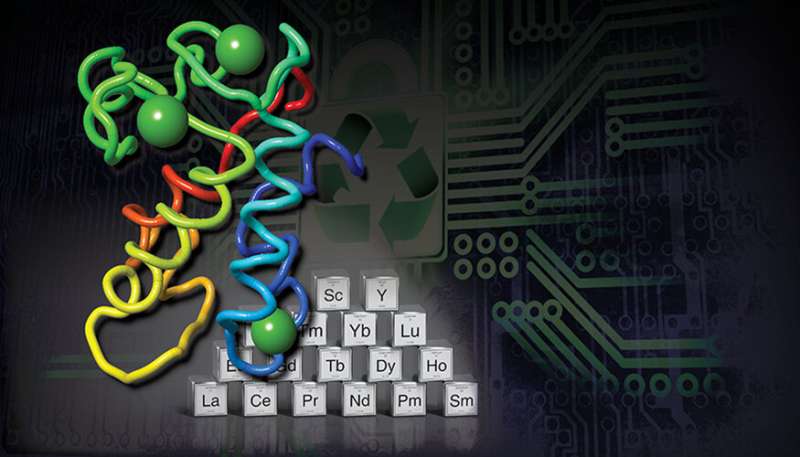E-waste-eating protein creates rare earth elements

Lawrence Livermore National Laboratory (LLNL) researchers, in collaboration with Pennsylvania State University (PSU) and Idaho National Laboratory (INL), have designed a new process, based on a naturally occurring protein, that could extract and purify rare earth elements (REE) from low-grade sources. It could offer a new avenue toward a more diversified and sustainable REE sector for the United States.
The protein, lanmodulin, enables a one-step extraction and purification of REEs from complex metal mixtures, including electronic waste and coal byproducts.
"Lanmodulin has several unique and exciting properties. We were all amazed to discover that a natural protein can be so efficient for metal extraction. I have worked on many molecules for metal purification but this one is really special," said LLNL researcher Gauthier Deblonde, lead author of a paper on this research appearing in Inorganic Chemistry. "This protein is the most REE-selective macromolecule characterized to date and is able to tolerate industrially relevant conditions such as low pH, high temperature and molar amounts of competing ions."
REEs are essential for American competitiveness in the clean energy industry because they are used in many devices important to a high-tech economy and national security, including computer components, high-power magnets, wind turbines, mobile phones, solar panels, superconductors, hybrid/electric vehicle batteries, LCD screens, night vision goggles and tunable microwave resonators.
To date, the chemical processes to extract and purify REEs are complex and harmful to the environment. Extracting or recycling REE from new sources, like electronic waste and coal byproducts, while using natural products, like lanmodulin, could be game-changing.
"Leveraging biomolecules for metal extraction technologies is appealing since most biochemical processes occur with quantitative yields, fast kinetics and high selectivity and fidelity," Deblonde said. "Our work also shows that bio-sourced macromolecules can outperform man-made chelators (small synthetic molecules that bind very tightly to metal ions) and may bring a shift to the currently highly constrained and non-sustainable methods used for REE extraction and purification."
In 2018, lanmodulin produced by certain bacteria was isolated and characterized by professor Joseph Cotruvo's team at PSU. It is the only known macro chelator that has naturally evolved to reversibly sequester REE ions. Classic macromolecules sequester elements like iron or calcium, but do not selectively sequester REEs. The LLNL and PSU teams investigated lanmodulin's solution chemistry and potential use for industry-oriented applications. Their work offers direct evidence that lanmodulin forms highly stable and water-soluble complexes across the lanthanide series while exhibiting minimal affinity for most non-REEs.
Further, the protein allows for a one-step quantitative and selective extraction of REEs from electronic waste and pre-combustion coal, something the other chemical extraction methods don't.
Journal information: Inorganic Chemistry
Provided by Lawrence Livermore National Laboratory


















